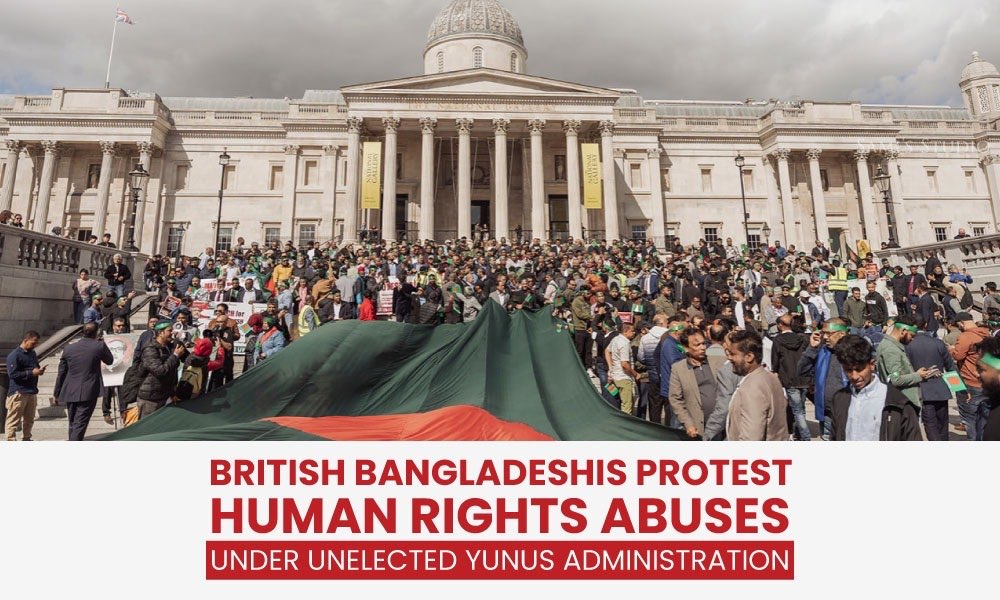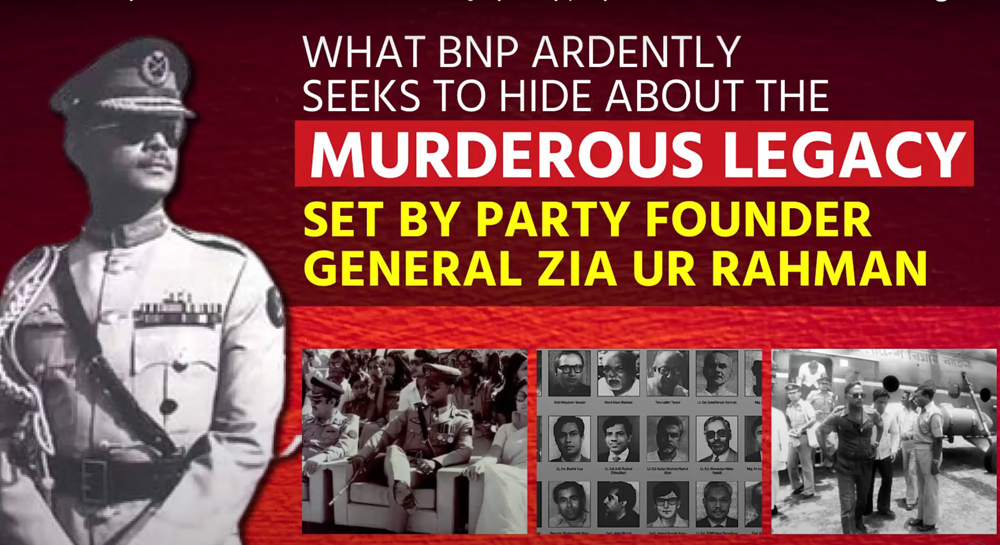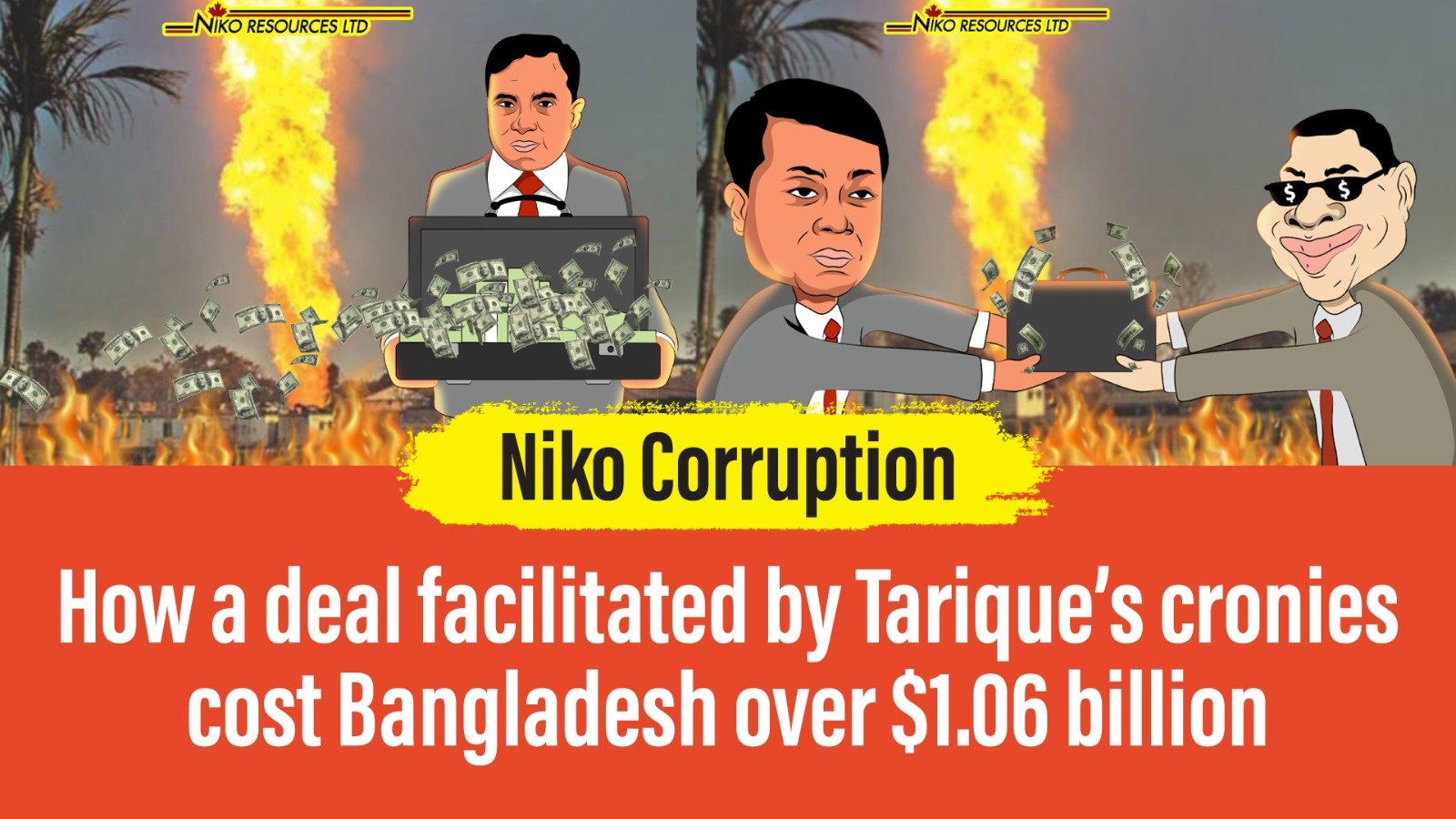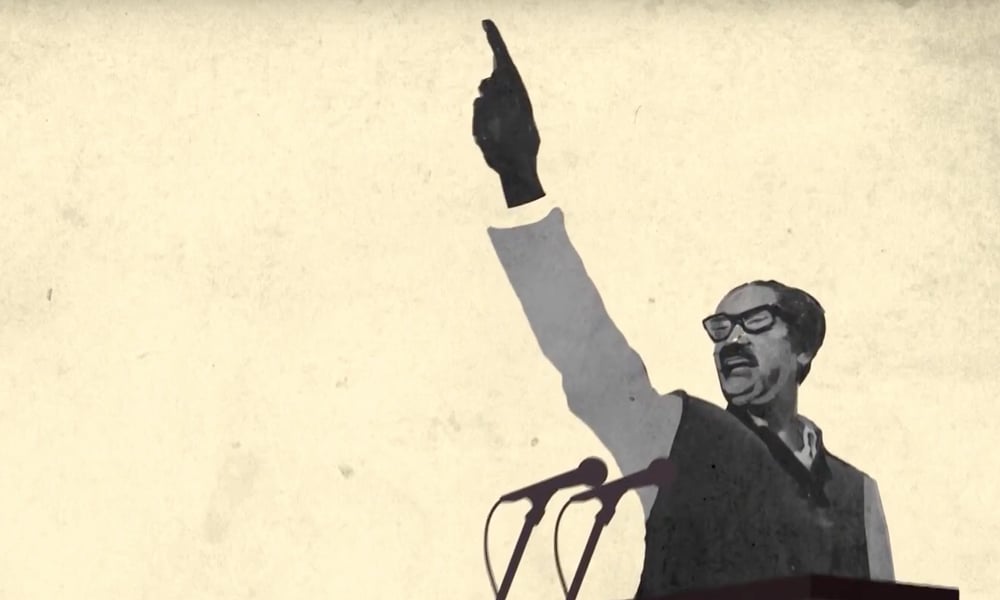The sun of Bengal’s freedom had descended with the defeat of Nawab Siraj-Ud-Daulah to British East India Company owing to the betrayal of his own commanders in the battle of Plassey in 1757. Subsequent colonial periods tell tales of anxiety, anguish, discrimination, oppression and so forth. No one knew when the descended sun of freedom would rise again, but everyone felt the necessity of a great leader who would free them from subjugation and restore the lost glory of Bengal. After a long wait for 163 years, from June 23, 1757 to March 17, 1920, the much-anticipated leader of Bangalees’ dream had come down to the earth from heaven in a small village of Tungipara in Gopalganj. From adolescent period, he would become deeply moved by people’s suffering and had no hesitation to take a stand for the oppressed. Thus he dedicated his life for the welfare of the people and soon became a symbol of hope and aspiration for their emancipation. Finally, he laid the foundation for the great war of liberation and successfully led the nation to freedom in 1971. Hence a new country called Bangladesh emerged in the world map and Bangalees regained their nationhood and sovereignty. That great leader is none other than our beloved Bangabandhu Sheikh Mujibur Rahman who is the Father of the Nation and the greatest Bengali of all time.
He had a dream of building a ‘Golden Bengal’ which would be free from hunger and poverty (note that his dream Bangladesh has now been turned into a digital Bangladesh). Therefore, upon his return from Pakistani prison after independence, he took no time to map out a clear blueprint to reconstruct the war-ravaged country. His well-thought-out plans helped the new-born nation tackle immediate economic and other challenges.
But regrettably, when the people was still deeply engrossed in their dream of building a prosperous country, a brutal military coup plunged the nation into an abyss of darkness. On 15 August 1975, the vested quarters of anti-liberation forces assassinated the architect of Bangladesh along with 20 members of his family with unprecedented brutality. Luckily, his two daughters – Sheikh Hasina, now the prime minister, and Sheikh Rehana –survived the massacre as they were out of the country at that time.
The killing was not an ordinary incident. The shamelessness of this crime was evidenced from the fact that the killers had shown the audacity to bring back the old ways of Pakistan days by erasing the ideals and values of the liberation war. In doing so the defeated force of the liberation war tried to annihilate Bangladesh, Bengali nationhood and the ideals of Bangabandhu.
Just nine days after the assassination, on 24 August 1975, Ziaur Rahman was made Chief of Army Staff. The Indemnity Ordinance which was issued on 26 September 1975 by Mushtaq was validated during the rule of Ziaur Rahman. Zia used parliament to include this black law in the Fourth Schedule of the Constitution through the 5th amendment to the constitution on 9 July 1979. Had Zia not given legitimacy to the black law, the assassins of 15th August could have been brought to justice after the withdrawal of martial law on April 9, 1979. Zia himself could do that. But not only had he refrained from taking any action against the killers, he made arrangements so that none could take action in future. With that purpose he spread propaganda that since the indemnity law has become part of the Constitution, it will not be easy to change it. He said a repeal of this law would require a two-thirds majority in parliament. But the reality is that a two-thirds majority is required to change the main part of the Constitution. A two-thirds majority is not required to change a scheduled law. Any law can be changed if there is a majority in parliament. But they spread the propaganda that the indemnity law cannot be changed. After the death of Zia, Justice Abdus Sattar, HM Ershad and Khaleda Zia came to power in subsequent terms, but when it came to repealing the Indemnity Ordinance, every one of them resorted to the same old excuse as propagated by Zia. As a result, the murderers had the temerity to openly talk about their involvement in the 15th August killings. It was not only shocking but also shameful for Bangladesh.
And yet, as if the Indemnity Ordinance had not demeaned the prestige of the nation sufficiently, after usurping power Zia further awarded the killers and abettors with prestigious diplomatic postings in Bangladesh missions abroad. Moreover, some of the killers were allowed to form a political party named Freedom Party. Then, Ziaur Rahman’s successors have desecrated the parliament by electing killer Bazlul Huda as a Member of Parliament from Meherpur-2 constituency in the fourth parliamentary election of 1988. Killer Syed Farooq Rahman was given the opportunity to contest in the presidential election of 1986, although his security deposit was confiscated in that election. Then in the voter less elections of February 1996, Khaleda Zia made killer Khandaker Abdur Rashid the leader of the opposition in parliament.
Independent commissions have been formed to investigate many political killings in the world. For example, after the killing of Indira Gandhi on 31 October 1984, a commission was formed named “Assassination of The Late Prime Minister Smt. Indira Gandhi.” Then, after the murder of Rajiv Gandhi on 21 May 1991, another commission was formed named “Assassination of Rajiv Gandhi”. Before that, the killing of John F Kennedy on 22 November 1963 has led to the formation of a committee named “The President's Commission on The Assassination of President Kennedy”. The Assassination of Anwar Sadat Commission was formed soon after the murder of the Egyptian president on 6 October 1981.
All those commissions worked independently and the trials of the killers were held in quickest possible time. Nowhere in the world have we found instance of enacting black law like Indemnity Ordinance to pardon killers. Bangladesh was exception in this regard.
However, it may be mentioned that after the assassination of Bangabandhu, a commission was formed in the United Kingdom with Sir Thomas William, Member of the British Parliament, as chairman, Nobel Peace Laureate Shaun McBride and British Parliamentarian Jeffrey Thomas as members, and Aubrey Rose as member secretary. But Ziaur Rahman did not allow that commission to see the light of the day. The members of the commission held their first meeting on 18 September 1980. From that meeting they decided to come to Bangladesh to investigate the killing. In this regard, they had sought help from Bangladesh Embassy in London. In January 1981, the commission applied for visa to visit Bangladesh, but to no avail. The members of the commission were not given visa and therefore there planned visit to Bangladesh didn’t happen. The Bangladesh Embassy in London neither informed them about why they were not given visa, nor received a couple of letters sent in this regard.
When the members of the commission were barred from entering Bangladesh, Zia was the president of the country, who came to the centre of power after the assassination of Bangabandhu. Although members of the commission were barred from coming to Bangladesh, the commission published a preliminary report on 20 March 1982.
The commission said in its report that the legal and judicial process in the case of Bangabandhu’s assassination was not allowed to proceed in its own course. And the Zia government is responsible for this. The independent Commission of Inquiry called on the Bangladesh government to remove obstacles in the way of justice, but it did not listen.
The report titled ‘Sheikh Mujib Murder Inquiry: Preliminary Report of the Commission of Inquiry’ was published from London in the form of a pamphlet. Its preface was written by Sheikh Hasina, daughter of Bangabandhu, who is now the Prime Minister of Bangladesh. As a show of confidence on the members of the UK-based commission, she wrote: “Their names guarantee that their investigations would have upheld the highest standards of justice.”
Finally, the trial of the Bangabandhu killing began when her daughter Sheikh Hasina came to state power 21 years after the incident. The self-declared killers were tried and sentenced to death in the due process of law and the sentence was carried out in respect of six of them while the hunt is on for five convicts running fugitive from law. The people demand full execution of the verdict by bringing back the rest of the fugitive killers. The government is also making effort in this regard.
But it is a matter of regret that those who pulled the strings from behind the scene during the gruesome killing have remained out of the purview of law. That’s why the demand of bringing the masterminds of 15th August killing is getting louder. It is also being demanded that those who have already died should be tried posthumously, because they are real perpetrators of the massacre. If they are allowed to go off the hook, it will only embolden them and their ilk to go on plotting such heinous crimes. They will think that the rule of law will not be able to trace their invisible hands. As a matter of fact they have been making repeated attempts to stage such incidents. For example, the eyes of the assassins have been trained on Sheikh Hasina since she returned to Bangladesh on May 17 in 1981, six years after the murder of her father Bangabandhu Sheikh Mujibur Rahman. Following is a chronology of the attacks on Sheikh Hasina:
Sheikh Hasina first came under attack in the same year she returned from abroad. Criminals of Freedom Party, which was consisted of the killers of Bangabandhu, tried to accomplish their unfinished job by killing Hasina.
Then on 24 January, 1988 there was a congregation of eight-party alliance at Laldighi Maidan in Chattogram. After landing in the Chattogram Air Port, Hasina got on a truck and was leading a rally towards the congregation ground. Armed assailants fired indiscriminately on the truck carrying Hasina. Luckily she survived narrowly.
On 11 August 1989, a group of armed criminals of Freedom Party, which was led by Bangabandhu’s killers Farque-Rashid, launched a grenade attack on Sheikh Hasina’s Dhanmondi residence. Sheikh Hasina was inside.
On 11 September 1991, Sheikh Hasina came under attack of BNP activists when she was visiting a polling centre at Green Road in the capital. Shots were fired by Zia’s followers as soon as she got out of the vehicle, but she escaped unhurt.
Another attempt was made to kill Sheikh Hasina during her train-march programme in Ishwardi on September 23 in 1994.
She was saved for the sixth time when she was addressing a rally at Russel Square at Panthapath in the capital on December 7 in 1995.
On 7 March 1996, when Hasina just finished her speech at a public rally at Bangabandhu Avenue assailants fired shots and threw bombs targeting the rally stage from a microbus.
Miscreants had planted a 76 kg bomb in her rally spot at Sheikh Lutfor Rahman College field at Gopalganj’s Kotaliparha on July 20, 2000. Sheikh Hasina was due to address a rally two days later. Fortunately, the bomb was recovered by detectives and she was saved again.
Again, Hasia was supposed to inaugurate Rupsha Bridge in Khulna on May 29 in 2001. But police found that explosives were planted under the bridge to kill her during the inauguration programme.
On September 25 in 2001 an attempt was made to kill Sheikh Hasina when she went to Sylhet for election campaign. A bomb exploded in a house barely 500 yards from the rally venue around 8pm, killing two people. Hasina survived as the bomb went off prematurely.
In 2002, when the BNP-led government was in power, a Juba Dal leader named Khalid attacked Hasina’s motorcade in front of Naogaon’s BMC Government Women’s College on March 4. Hasina was the opposition leader then.
On September 30 of that year, BNP and Jamaat-e-Islami activists barricaded the road at Satkhira’s Kolaroa and attacked Hasina’s motorcade. Media reported that the then ruling party MP of that constituency was directly involved in the attack.
Shots were fired on Hasina’s motorcade by the then BNP-Jamaat cadres at Barisal’s Gournadi on April 2, 2004.
Then she survived the deadliest attempt on her life on August 21 in 2004. The Awami League President Sheikh Hasina was speaking at a ‘peace rally’ at Bangabandhu Avenue. The gruesome attack was launched as soon as she finished her speech. At least 13 grenades were thrown from the rooftops of a nearby building which left 24 leaders and activists, including wife of late President Zillur Rahman and Mahila Awami League chief Ivy Rahman and 400 others injured. Although, Hasina narrowly escaped death, one of her ears’ hearing capacity was damaged and she also suffered various physical problems. Many of the victims could never return to normal life.
To a large extent, impunity of the masterminds of 15th August killing is responsible for all those attacks on Sheikh Hasina. Therefore, formation of a national commission to trace and punish the conspirators of Bangabandhu killing is need of the hour. It appears that the government too is positive about taking steps in this regard, which is welcome. We have to uproot the conspirators and their followers so that they cannot disturb the ongoing process of building Bangabandhu’s dream Bangladesh. By bringing the masterminds to book we can also set the record straight about the most brutal political killing in world history.
Many of those who were in responsible positions during that time cannot evade responsibility of Bangabandhu’s assassination. Those who were directly involved have been brought to justice, but it is time to find out those who backed the killers and hatched the plot to kill father of the nation. The demand in this respect is becoming increasingly loud and clear, while it is being hinted that the government is looking into the matter positively. The bottom-line is, if we want to free the country from the heinous clutch of assassins and conspirators, formation of the aforesaid commission is a must.
The writer is the Vice-chancellor, Bangabandhu Sheikh Mujibur Rahman Digital University, Bangladesh.














